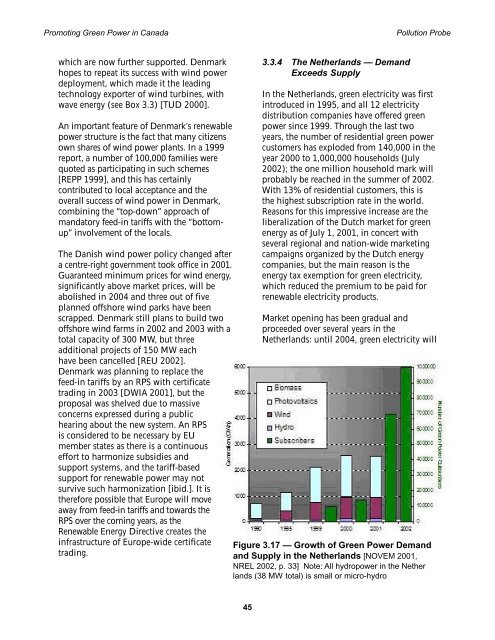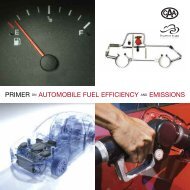<strong>Promot<strong>in</strong>g</strong> <strong>Green</strong> <strong>Power</strong> <strong>in</strong> <strong>Canada</strong> Pollution Probethe <strong>in</strong>frastructure to <strong>in</strong>tegrate w<strong>in</strong>d farms<strong>in</strong>to the electricity grid is paid <strong>for</strong> by allconsumers [HAAS 2001, p. 22f.]. The feed-<strong>in</strong>tariff, together with the production tax credit,represents a per-kWh support equivalent to9.4¢ CDN/kWh.In addition, Denmark has implemented a setof measures, <strong>in</strong>clud<strong>in</strong>g ensur<strong>in</strong>g that theenergy supply to small communities is metby biomass-based district heat<strong>in</strong>g of CHP(rather than natural gas); <strong>in</strong>creas<strong>in</strong>g theflexibility of regulations govern<strong>in</strong>g thequantities of wood chips and straw to beused <strong>in</strong> electricity generation; mak<strong>in</strong>g w<strong>in</strong>dturb<strong>in</strong>e plann<strong>in</strong>g a regular feature of regionaland municipal plann<strong>in</strong>g; promot<strong>in</strong>g solarheat<strong>in</strong>g through collaboration with energydistribution companies; and sett<strong>in</strong>g up ademonstration geothermal plant. The 1997Biomass Agreement requires energycompanies to use at least 1 million tons ofstraw, 0.2 mt of wood chips and 0.2 mt ofeither straw, wood chips or willow per year,<strong>in</strong> order to m<strong>in</strong>imize the need <strong>for</strong> expensiveimports of straw from neighbour<strong>in</strong>gcountries. Total biomass <strong>in</strong>c<strong>in</strong>eration shouldbe 19.5 PJ/year (0.46 Mtoe) from 2000onwards. Another part of the plan allows<strong>in</strong>dividual towns and communities to adopt,if they wish, biomass technologies on theirown <strong>in</strong>itiative [IEA 1998]. Switch<strong>in</strong>g fuelsfrom coal to biomass is supported with an<strong>in</strong>vestment subsidy of nearly 50% [FIRE1998, p. 22]. Denmark is also on its way tobecom<strong>in</strong>g a world leader <strong>in</strong> wave energy. TheDanish Wave Energy Program was <strong>in</strong>itiated<strong>in</strong> 1998 and is funded with €5.3 million(about $7.4 million CDN) over a period of 4years. The Program is designed to <strong>in</strong>volve thegeneral public and has allowed <strong>for</strong> over 40different concepts to be evaluated, n<strong>in</strong>e ofBox 3.3 — The Danish Wave <strong>Power</strong> InitiativeIn Denmark, wave energy has an appealto what one could call the “populareng<strong>in</strong>eer<strong>in</strong>g spirit.” Many people haveideas <strong>for</strong> wave-energy mach<strong>in</strong>es andstarted test<strong>in</strong>g them <strong>in</strong> their backyards.Many of these people and <strong>in</strong>ventors, firmsand <strong>in</strong>stitutions are organized as the“Association <strong>for</strong> the Promotion of WaveEnergy,” which was established <strong>in</strong> 1997.Important government fund<strong>in</strong>g wasobta<strong>in</strong>ed as the left-w<strong>in</strong>g party, the UnityList, which favours wave energy overbiofuels <strong>for</strong> ecological reasons, jo<strong>in</strong>ed therul<strong>in</strong>g party to support wave energy <strong>in</strong> 1997.Denmark’s new <strong>in</strong>itiative is build<strong>in</strong>g on itssuccess with the development of w<strong>in</strong>dturb<strong>in</strong>es, which <strong>in</strong> contrast to othercountries was truly built on broad popular<strong>in</strong>terest and <strong>in</strong>itiative — a “bottom-up”development. Instead of its old waveenergyprogram, which focused on thedevelopment of one s<strong>in</strong>gle technicalconcept, the new program has its popularand political base <strong>in</strong> the “Folk Center <strong>for</strong>Renewable Energy,” an <strong>in</strong>dependent<strong>in</strong>stitution under the Danish EnergyAgency, which develops susta<strong>in</strong>ableenergy technologies <strong>for</strong> Danish firms withstate fund<strong>in</strong>g. A network of about 300<strong>in</strong>dividuals, private companies and<strong>in</strong>stitutions <strong>in</strong>terested <strong>in</strong> wave energy hasbeen developed s<strong>in</strong>ce 1993 by writ<strong>in</strong>garticles, hold<strong>in</strong>g conventions at regular<strong>in</strong>tervals and issu<strong>in</strong>g letters and<strong>in</strong><strong>for</strong>mation.An important factor is the openness of theentire process, to allow all those <strong>in</strong>volvedto participate <strong>in</strong> a process of developmentand learn<strong>in</strong>g, so that one concept canfertilise another and design components betransferred from one concept to another,to concentrate on a handful of mach<strong>in</strong>esthat will pave the way <strong>for</strong> the f<strong>in</strong>albreakthrough of wave energy [WEDK 1998].44
<strong>Promot<strong>in</strong>g</strong> <strong>Green</strong> <strong>Power</strong> <strong>in</strong> <strong>Canada</strong> Pollution Probewhich are now further supported. Denmarkhopes to repeat its success with w<strong>in</strong>d powerdeployment, which made it the lead<strong>in</strong>gtechnology exporter of w<strong>in</strong>d turb<strong>in</strong>es, withwave energy (see Box 3.3) [TUD 2000].An important feature of Denmark’s renewablepower structure is the fact that many citizensown shares of w<strong>in</strong>d power plants. In a 1999report, a number of 100,000 families werequoted as participat<strong>in</strong>g <strong>in</strong> such schemes[REPP 1999], and this has certa<strong>in</strong>lycontributed to local acceptance and theoverall success of w<strong>in</strong>d power <strong>in</strong> Denmark,comb<strong>in</strong><strong>in</strong>g the “top-down” approach ofmandatory feed-<strong>in</strong> tariffs with the “bottomup”<strong>in</strong>volvement of the locals.The Danish w<strong>in</strong>d power policy changed aftera centre-right government took office <strong>in</strong> 2001.Guaranteed m<strong>in</strong>imum prices <strong>for</strong> w<strong>in</strong>d energy,significantly above market prices, will beabolished <strong>in</strong> 2004 and three out of fiveplanned offshore w<strong>in</strong>d parks have beenscrapped. Denmark still plans to build twooffshore w<strong>in</strong>d farms <strong>in</strong> 2002 and 2003 with atotal capacity of 300 MW, but threeadditional projects of 150 MW eachhave been cancelled [REU 2002].Denmark was plann<strong>in</strong>g to replace thefeed-<strong>in</strong> tariffs by an RPS with certificatetrad<strong>in</strong>g <strong>in</strong> 2003 [DWIA 2001], but theproposal was shelved due to massiveconcerns expressed dur<strong>in</strong>g a publichear<strong>in</strong>g about the new system. An RPSis considered to be necessary by EUmember states as there is a cont<strong>in</strong>uousef<strong>for</strong>t to harmonize subsidies andsupport systems, and the tariff-basedsupport <strong>for</strong> renewable power may notsurvive such harmonization [ibid.]. It isthere<strong>for</strong>e possible that Europe will moveaway from feed-<strong>in</strong> tariffs and towards theRPS over the com<strong>in</strong>g years, as theRenewable Energy Directive creates the<strong>in</strong>frastructure of Europe-wide certificatetrad<strong>in</strong>g.3.3.4 The Netherlands — DemandExceeds SupplyIn the Netherlands, green electricity was first<strong>in</strong>troduced <strong>in</strong> 1995, and all 12 electricitydistribution companies have offered greenpower s<strong>in</strong>ce 1999. Through the last twoyears, the number of residential green powercustomers has exploded from 140,000 <strong>in</strong> theyear 2000 to 1,000,000 households (July2002); the one million household mark willprobably be reached <strong>in</strong> the summer of 2002.With 13% of residential customers, this isthe highest subscription rate <strong>in</strong> the world.Reasons <strong>for</strong> this impressive <strong>in</strong>crease are theliberalization of the Dutch market <strong>for</strong> greenenergy as of July 1, 2001, <strong>in</strong> concert withseveral regional and nation-wide market<strong>in</strong>gcampaigns organized by the Dutch energycompanies, but the ma<strong>in</strong> reason is theenergy tax exemption <strong>for</strong> green electricity,which reduced the premium to be paid <strong>for</strong>renewable electricity products.Market open<strong>in</strong>g has been gradual andproceeded over several years <strong>in</strong> theNetherlands: until 2004, green electricity willFigure 3.17 — Growth of <strong>Green</strong> <strong>Power</strong> Demandand Supply <strong>in</strong> the Netherlands [NOVEM 2001,NREL 2002, p. 33] Note: All hydropower <strong>in</strong> the Netherlands (38 MW total) is small or micro-hydro45
















